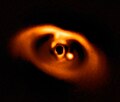Overview
NESSI, a $3.5 million instrument, is the first purpose-built device for the analysis of exoplanet atmospheres, [4] and is expected to have a powerful impact on the field of exoplanet characterization. [6] The Principal Investigator is Michelle Creech-Eakman at the New Mexico Institute of Mining and Technology, working with seven co-investigators [6] from New Mexico Tech, Magdalena Ridge Observatory, and NASA JPL. It is partly funded by NASA's Experimental Program to Stimulate Competitive Research, in partnership with the New Mexico Institute of Mining and Technology. [2]
The NESSI spectroscope was mounted on the institute's 2.4 meter telescope at the Magdalena Ridge Observatory in Socorro County, New Mexico, USA, [4] and its first exoplanet observations began on April 7, 2014. In 2016 a contract was established with JPL to retrofit NESSI with new foreoptics and a mounting collar for use on the Hale Telescope at the Palomar Observatory. NESSI achieved first light on the Hale Telescope in Feb, 2018 and was undertaking a series of observations to establish its sensitivity and precision for exoplanet spectroscopy.
NESSI will capture the spectra of both the star and the planet during the transit and then allow scientists to deduct the composition of the planet's atmosphere. The novel technology is expected to achieve high definition readings by using algorithms to calibrate and compensate for time-variable telluric features and instrumental variability throughout an observation. [6]
This page is based on this
Wikipedia article Text is available under the
CC BY-SA 4.0 license; additional terms may apply.
Images, videos and audio are available under their respective licenses.



